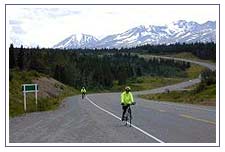
If a 200 year-old trail goes through private lands, does a new landowner have the right to close it? Sunday we hiked to the summit of Mt. Cabot, the northern-most of the NH 4000fters via the Bunnell Notch Trail as the person who owned the first mile of the traditional Mt. Cabot trail has closed it to hikers. Don't get me wrong, the Bunnell Notch trail is a fine trail, and since the closure of the other some wonderful folks have added a number of stone steps, bog bridges and reroutes to drier land, but when you join up with the remainder of the old Cabot trail on the West side of the mountain, you realize that not only was it the most direct route to the summit, it was also an historic trail. From the careful placement of the stones, and the carefully chosen switchbacks, it becomes obvious that this, like yesterday's Starr King trail, was also one of the historic bridal paths constructed in the 1850's when the Grand Trunk Railroad came through Gorham, NH making it the center of the Victorian hiking experience.
According to the
AMC White Mountain Guide
and the
various forums on the internet, the property owner closed the trail sometime in the early 2000's. Although there was optimism that it would reopen (following negotiation with various clubs?/lawsuits?) it is still closed and that section has been removed from all official maps. Some hikers feel justified in trespassing, either through disregard, or as a political statement, maintaining that the trail is protected by a deeded, legal right of way. Others believe the owner closed the trail to avoid possible liability lawsuits.
Trails crossing private lands is not a new, or even unusual thing. Many times while hiking in the Whites, and other places, a sign on the trail will notify hikers that they are entering/leaving private land. The signs also usually ask that the hiker stay on the rail. Most hikers honor the request, most landowners allow the trails to continue. But as with all things, there are the exceptions.
I can understand some of the landowners concerns. Not all hikers adhere to Leave No Trace, not all assume personal responsibility for their well being on the trail. Some have even been known to sue the folks who rescue them. But there are laws to protect the homeowner and I do believe that if you purchased a piece of land with an existing trail, and in this case, an historic trail, you have an obligation to keep that trail open. If you can not fulfill that obligation then don't buy the property, or deed the land over to a land trust that can open the trail.
As it stands now there are three trails to the summit of Mt. Cabot. One that 'starts' in the middle of the woods on the border of the White Mountain National Forest land, one, the Kilkenney Ridge trail – which is an overnight backpacking trek a long a scenic ridge, and the Bunnell Notch Trail. I chose the path of least resistance, and am a bit disturbed by the situation.
 Starting form Tripoli Road, a unique combination of fire road/campground, the trail crosses two brooks then begins a gentle ascent along an old road. One guide book called it a logging road, but another book, Logging railroads of the Saco River Valley
Starting form Tripoli Road, a unique combination of fire road/campground, the trail crosses two brooks then begins a gentle ascent along an old road. One guide book called it a logging road, but another book, Logging railroads of the Saco River Valley



